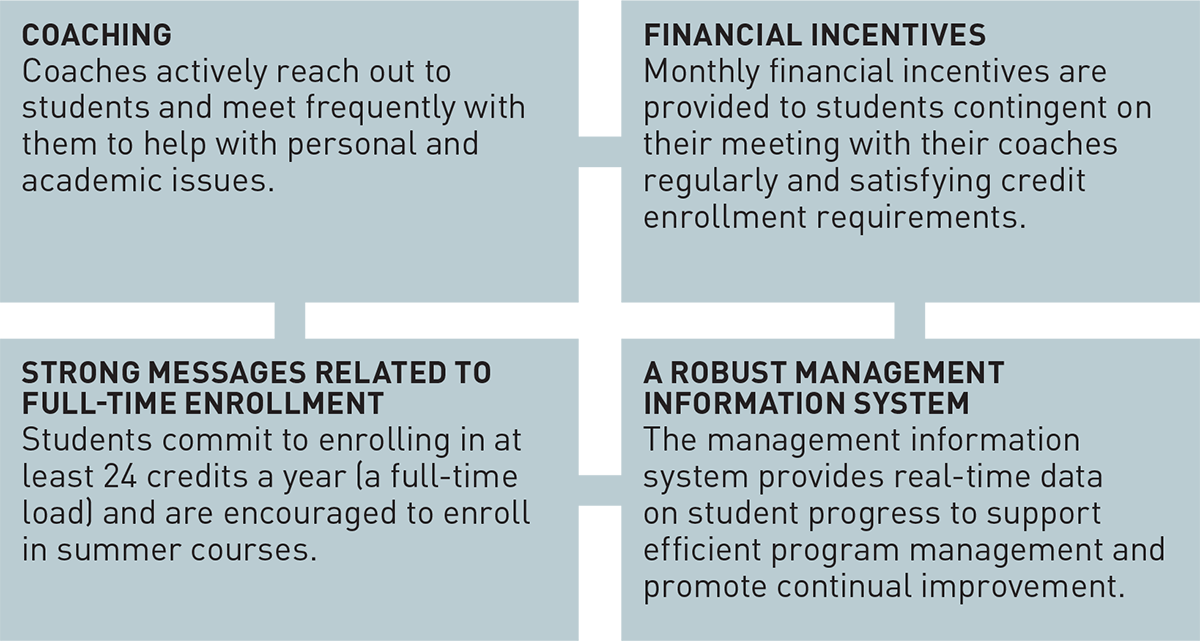Implementing Evidence-Based Programs to Support College Success

This issue focus was updated in March 2021.
MDRC’s Scaling Up College Completion Efforts for Student Success (SUCCESS) aims to increase graduation rates for low-income students and students of color by partnering with states and colleges to implement large-scale, financially sustainable support programs based on strong evidence. SUCCESS combines components that have been proven to help students succeed in college into a single, integrated program that lasts for three years:[1]

Underlying the program model is a commitment from state postsecondary leaders and colleges to build programs that are financially sustainable and that can be expanded to large numbers of students and colleges, realized in part by aligning programs with statewide initiatives and using existing financial resources to reduce costs.
An Early Look at Participating States and Colleges
MDRC has recruited thirteen colleges across five states to participate in SUCCESS since the initiative launched. (See below for a list of participating states and colleges.) These college and state partners were selected because SUCCESS aligns strongly with their student success priorities and because they are committed to sustaining SUCCESS financially and expanding it to additional students. MDRC is providing in-depth technical assistance on program design and operation to the colleges, most of which began implementing their SUCCESS programs in the 2019-2020 academic year.
| State Partners | Community Colleges | |
|---|---|---|
| California |
|
|
| Indiana |
|
|
| Minnesota |
|
|
| New Jersey |
|
|
| Ohio |
|
|
Each college’s program incorporates the four components of SUCCESS described above into an integrated program, and all of the colleges are serving low-income, associate degree- or certificate-seeking students. Three of the programs are targeting students of color to improve outcomes for these students. These colleges are working to add into their programs culturally responsive practices designed to support students of color, such as connecting students with peer mentors of the same background or holding identity-based group meetings to foster a sense of community. The colleges are also using insights from behavioral science to improve student outreach and engagement. For financial incentives, most colleges are providing $50 monthly gift cards for items such as food and textbooks, contingent on students satisfying requirements to meet with their coaches regularly and reach credit-enrollment benchmarks.
Colleges have deliberately aligned their SUCCESS programs with statewide initiatives and priorities. Doing so has allowed colleges to use existing financial resources, staff, and program infrastructure to support SUCCESS. They hope it will also help with scale and financial sustainability in the long term.
- Guided Pathways: Many of the SUCCESS colleges have aligned their programs with guided pathways, an approach to college-wide reform that emphasizes high levels of support for students and clearly defined programs of study. For example, SUCCESS coaches at some colleges are using guided-pathways degree maps (which lay out required course sequences and progress milestones) when they meet with students. The California and New Jersey colleges have designed SUCCESS to be a strategy under guided pathways and are building their programs on top of recent reforms such as enhanced coaching.
- College Affordability: All SUCCESS colleges are concerned with finding ways to help students cover their costs. For example, several of the SUCCESS colleges are using College Promise programs, which typically cover students’ college tuition and fees, to provide additional financial support to SUCCESS students. In New Jersey, the colleges are taking advantage of the statewide Community College Opportunity Grant to support SUCCESS students. In California, one college’s SUCCESS program is built on its Finish in Four Initiative, which uses statewide College Promise funds to cover students’ tuition and fees and encourages students to enroll full time and finish associate’s and bachelor’s degrees in four years.
- Equity: SUCCESS programs have been designed to help meet state and institutional priorities of improving educational equity for historically underrepresented students. As noted above, three of the colleges are serving students of color in order to close racial gaps in college outcomes. In Indiana, Ivy Tech Community College’s five-year strategic plan calls on each campus to build its ability to provide nonacademic support to students and to achieve equitable student outcomes, making SUCCESS a natural fit. In Ohio, SUCCESS is aligned with the state’s priority to improve equity and provide enhanced student services contingent on full-time enrollment as a way of accelerating degree completion.
A Focus on Expansion and Sustainability
The colleges and state partners have committed to developing plans to sustain SUCCESS financially, expand it within institutions, and spread it to other colleges in the state. The state partners will play an important role in these efforts, helping to convene colleges and identify existing and new resources to support SUCCESS. To help colleges and states make decisions about budgeting and program expansion, MDRC has developed a return-on-investment tool that estimates the amount of revenue SUCCESS will generate for each college based on its tuition price and state funding formula. Most of the program costs are likely to be offset by the additional revenue generated—and at some colleges, the programs have the potential to pay for themselves entirely.
The Evaluation of SUCCESS
MDRC plans to conduct an implementation study, an impact study, and a cost-effectiveness study. Using a random assignment design, MDRC will evaluate the effect of SUCCESS on student outcomes including persistence in college, credit accumulation, and graduation. Early findings will be released in 2022. MDRC also plans to document how colleges sustain SUCCESS financially and the role states play in advancing evidence-based student support programs.
To learn more about the project, visit www.mdrc.org/project/success.
[1]A growing body of research suggests that combining multiple evidence-based strategies into a single, multiyear program can produce substantial improvements in student outcomes. Examples of such programs include the City University of New York’s Accelerated Study in Associate’s Programs, which has been found to double graduation rates in rigorous evaluations; Valley Initiative for Development and Advancement; One Million Degrees; and the Dell Scholars program.







